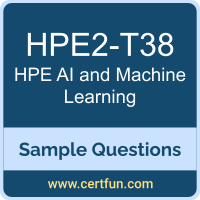 Getting knowledge of the Hewlett Packard Enterprise HPE2-T38 exam structure and question format is vital in preparing for the HPE AI and Machine Learning certification exam. Our HPE AI and Machine Learning sample questions offer you information regarding the question types and level of difficulty you will face in the real exam. The benefit of using these Hewlett Packard Enterprise HPE2-T38 sample questions is that you will get to check your preparation level or enhance your knowledge by learning the unknown questions. You will also get a clear idea of the exam environment and exam pattern you will face in the actual exam with the HPE AI and Machine Learning Sample Practice Test. Therefore, solve the HPE AI and Machine Learning sample questions to stay one step forward in grabbing the HPE Product Certified - AI and Machine Learning credential.
Getting knowledge of the Hewlett Packard Enterprise HPE2-T38 exam structure and question format is vital in preparing for the HPE AI and Machine Learning certification exam. Our HPE AI and Machine Learning sample questions offer you information regarding the question types and level of difficulty you will face in the real exam. The benefit of using these Hewlett Packard Enterprise HPE2-T38 sample questions is that you will get to check your preparation level or enhance your knowledge by learning the unknown questions. You will also get a clear idea of the exam environment and exam pattern you will face in the actual exam with the HPE AI and Machine Learning Sample Practice Test. Therefore, solve the HPE AI and Machine Learning sample questions to stay one step forward in grabbing the HPE Product Certified - AI and Machine Learning credential.
These Hewlett Packard Enterprise HPE2-T38 sample questions are simple and basic questions similar to the actual HPE AI and Machine Learning questions. If you want to evaluate your preparation level, we suggest taking our HPE AI and Machine Learning Premium Practice Test. You might face difficulties while solving the real-exam-like questions. But, you can work hard and build your confidence on the syllabus topics through unlimited practice attempts.
Hewlett Packard Enterprise HPE2-T38 Sample Questions:
01. What is the role of a hidden layer in an artificial neural network (ANN)?
a) It receives and weighs inputs from the preceding layer and produces outputs for the next layer.
b) It assigns the label to a record, or in other words, produces the final result for the ANN.
c) It ingresses parameters from a record and passively reformats those parameters without any changes over the training process.
d) It does not play a role during the forward pass of data through the ANN, but it helps to optimize during the backward pass.
02. For large-scale machine learning solutions, what type of data handling capability is essential?
a) Ability to handle small, static datasets only
b) Capability to process and analyze large, dynamic datasets
c) Only cloud-based data handling is required
d) The ability to process data is not important
03. What is the importance of data preprocessing in machine learning solutions?
a) It enhances the performance and accuracy of models
b) It is not necessary
c) It is only for visualizing data
d) It is only required for text data
04. Why are loyalty programs an effective tool in customer engagement?
a) They discourage repeat purchases
b) They offer rewards and incentives for customer loyalty
c) They have no impact on customer behavior
d) They are only beneficial for high-spending customers
05. How can HPE ML solutions affect a business's time-to-market for new products or services?
a) They significantly increase time-to-market
b) They have no effect on time-to-market
c) They can reduce time-to-market with faster insights and development
d) They only focus on post-market analysis
06. What is the impact of HPE ML solutions on a business's operational efficiency?
a) Increased reliance on manual processes
b) Minimal impact on operations
c) Decrease in overall efficiency
d) Significant improvement in operational efficiency
07. When it comes to data privacy compliance, how do HPE solutions compare to open-source?
a) HPE solutions often have more robust compliance mechanisms
b) Open-source versions are better at ensuring compliance
c) Both are equally effective in compliance
d) Neither addresses data privacy compliance
08. In the context of HPE machine learning solutions, what role does GPU acceleration play?
a) It is optional and not very beneficial
b) It speeds up model training and inference
c) It is only used for graphical outputs
d) It reduces the accuracy of models
09. What is a key benefit of HPE Machine Learning solutions in terms of integration with existing enterprise systems?
a) More complex integration than open-source
b) Similar integration challenges as open-source
c) Easier and more seamless integration
d) No integration capabilities
10. Which of the following is essential for optimizing ML models with the HPE ML PDK?
a) Access to HPE’s proprietary data
b) Expertise in a specific programming language
c) Constant internet connectivity
d) Understanding of model optimization techniques
Answers:
|
Question: 01 Answer: a |
Question: 02 Answer: b |
Question: 03 Answer: a |
Question: 04 Answer: b |
Question: 05 Answer: c |
|
Question: 06 Answer: d |
Question: 07 Answer: a |
Question: 08 Answer: b |
Question: 09 Answer: c |
Question: 10 Answer: d |
Note: For any error in HPE AI and Machine Learning (HPE2-T38) certification exam sample questions, please update us by writing an email on feedback@certfun.com.
